
Logania distanti, the dark mottle, is a small but striking butterfly found in India that belongs to the lycaenids or blues. It was first described by Georg Semper in 1889.

Nacaduba angusta, the white lineblue, is a lycaenid butterfly found in South Asia. The species was first described by Herbert Druce in 1873.

Prosotas nora, the common lineblue, is a species of lycaenid butterfly found in Asia to Australia. The species was first described by Rudolf Felder in 1860.

Nacaduba pavana, the small four-line blue or Singapore four-line blue, is a species of lycaenid butterfly found in Southeast Asia.

Nacaduba berenice, the rounded six-line blue, is a lycaenid butterfly found in Indomalayan realm. The species was first described by Gottlieb August Wilhelm Herrich-Schäffer in 1869.
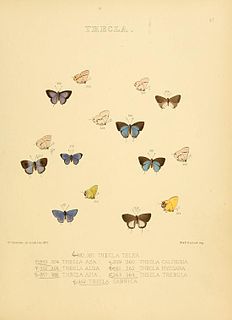
Dicya is a genus of butterflies in the family Lycaenidae. The species of this genus are found in the Neotropical realm.
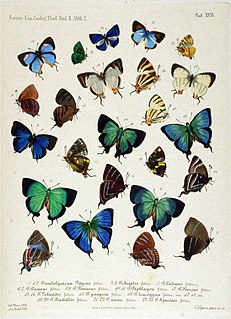
Erora is a genus of butterflies in the family Lycaenidae erected by Samuel Hubbard Scudder in 1872. The species of this genus are found in the Nearctic and Neotropical realms.

Ithomiini is a butterfly tribe in the nymphalid subfamily Danainae. It is sometimes referred to as the tribe of clearwing butterflies or glasswing butterflies. Some authors consider the group to be a subfamily (Ithomiinae). These butterflies are exclusively Neotropical, found in humid forests from sea level to 3000 m, from Mexico to Argentina. There are around 370 species in some 40–45 genera.

Callicore is a genus of nymphalid butterfly found in the Neotropical realm. This genus, like some related ones, was formerly lumped together as the paraphyletic Catagramma assemblage.
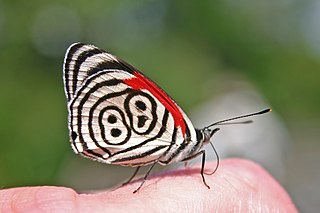
Diaethria is a brush-footed butterfly genus found in the Neotropical realm, ranging from Mexico to Paraguay.
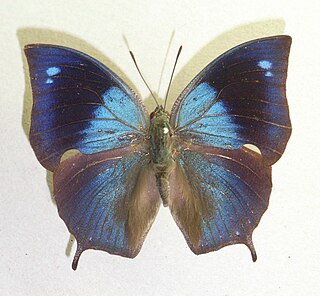
Memphis, described by Jacob Hübner in 1819, is a Neotropical nymphalid butterfly genus in the subfamily Charaxinae.

Symbiopsis is a Neotropical genus of butterflies in the family Lycaenidae.

Theclopsis is a genus of butterflies in the family Lycaenidae. The species of this genus are found in the Neotropical realm.

Mimoniades is a Neotropical genus of skipper butterflies in the family Hesperiidae.
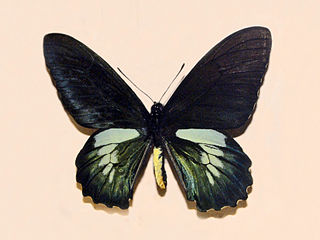
Battus laodamas, the green-patch swallowtail or yellow-spotted swallowtail, is a species of butterfly in the family Papilionidae.

Parides photinus, the pink-spotted cattleheart, is a species of butterfly in the family Papilionidae. It was first described by Edward Doubleday in 1844.

Tithorea tarricina, the tarricina longwing, variable presonian, or cream-spotted tigerwing, is a species of butterfly belonging to the family Nymphalidae.
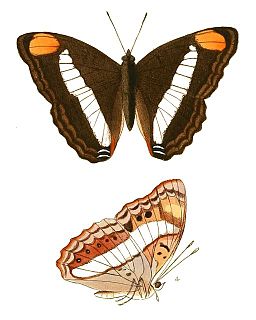
Doxocopa pavon, the Pavon emperor or Pavon, is a species of butterfly in the family Nymphalidae. They can be found from Paraguay in South America up to Texas in the southern United States. They are generally brown in their overall coloration, with two bands of white straddling the middle of the upper surfaces of the wings, and a patch of orange on the tips of their forewings. The upper surfaces of the wings of the males are overlaid by an iridescent blue-purple sheen. The females of the species closely resemble members of the unrelated genus Adelpha.
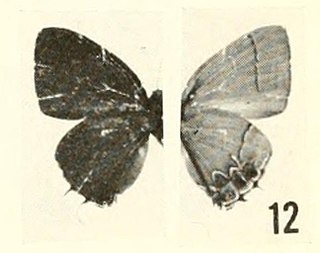
Calycopis pisis, the pisis groundstreak, is a butterfly found in several countries in Latin America.
Ipidecla schausi, also called Schaus' hairstreak or Salvin's dwarf, is a small butterfly in the family Lycaenidae, sub-family Theclinae and genus Ipidecla.



















